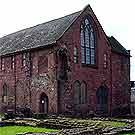Hales' Place

Base layers
Data layers

Other Images
Venue Type & Location
Site Name: Hales' Place
Location: Coventry
County: Coventry (city-county) in Warwickshire
Location Type: Town - in town at determined location
Overview
The E (cloister) range of the former Whitefriars Monastery remains standing at the junction of London Road and Gulson Road. The gabled 2-storey building, of local stone ashlar, was converted for use as a residence by John Hales in the 16th c.
The ground floor is divided longitudinally, with the stone-vaulted, 11-bay cloister on the W and 2 long, vaulted rooms, lit by pointed 14th c. windows, to the E. The upper floor was undivided and is thought to have been the friars' dormitory. Some single-light windows with ogee heads have survived on the E and end walls.
Performance History
Probable performance venue. Although local records of John Hales' players do not survive, they were recorded elsewhere in Bristol, in the 1560s.
Current Status
Known once again as the Whitefriars. Owned by Coventry City Council and used as a museum store (until 2007).
History of the Venue
1342 Whitefriars house founded. Church and conventual buildings erected during the next century.
1506 Cloister completed.
1538 Whitefriars surrendered at the Dissolution. Property reverted to the Crown.
1544 Sold first to Sir Ralph Sadler and subsequently to John Hales. Some buildings demolished but the E range of the cloister converted for use as a residence. Many alterations made, including the construction of new gable-ends to the truncated N and S ranges, the insertion of partitions, fireplaces, staircases, and many new windows. The central part of the upper storey was converted into a long room with a coved plaster ceiling, an oriel window facing W, a large fireplace opposite, and a panelled screen across its S end (VCH Warw 8.134).
An extension at the NE contained a chapel. The former cloister garth became the forecourt entered by a gateway in its N wall, built across the site of the S transept of the church. House also extended at the S end.
The chancel of the Whitefriars' church was initially used for a grammar school, relocated after the city corporation acquired it for use as a church.
1572 Most of the friars' church demolished and fabric sold.
1574 Church steeple fell.
1642 House damaged during the bombardment of New Gate.
1717 Sold to the Duke of Montague by Sir Christopher Hales to pay for debts.
1723 Sold to Samuel Hill of Staffordshire. Occupied by Jersey combers and weavers.
late 18th c. Sold to the Rev. W. Smith of Bedfordshire and occupied by poor families.
1801--4 Acquired to serve as a workhouse, with an additional new block. Former cloister glazed and used as a dining room. The upper floor divided longitudinally by a brick wall with other new partitions. The 4 central bays of the roof appear to have been strengthened by the addition of tie-beams to the trusses, and were probably of the arch-braced collar-beam type. Elsewhere queen-post tie-beam trusses have survived, as well as some of the curved wind-braces of the 16th c. roof.
The timber-framed buildings round the south courtyard were gradually replaced: in 1843 by a W block with 'Tudor' window glazing, and in 1863 by several blocks in red and blue brick.
Later 19th c. Restoration work, including the addition of several new traceried windows.
1940 Severely damaged by bombs. Parts of the old workhouse occupied as a hostel by the Salvation Army.
1948 Ceased to be used as a workhouse. Parts of the building used as a hostel by the Salvation Army.
1965 Restoration for use as a museum began by the city architecture and planning department. The work included 'the lowering of the ground floor to its original level and the removal of all partitions in the former dormitory so that it could be used as a museum gallery. There was much restoration of stonework and timber, but wherever possible medieval and 16th-century features were preserved' (VCH Warw 8.134).
Record Source
REED Bristol 72
Patrons who owned this venue
| Name | Dates | Titles |
|---|---|---|
| Hales, John | 1516-1572 |
Bibliographic Sources
-
Fretton, W.G. 'Memorial of the Whitefriars, Coventry.' Transactions of the Birmingham and Midland Archaeological Society 3 (1872): 63–78.
-
McGrory, David. A History of Coventry. Chichester: Phillimore & Co., 2003.
-
Page, William, ed. The Victoria History of the County of Warwick. The Victoria History of the Counties of England. 8 vols. London: Archibald Constable & Co. [vols 1-–2]; Oxford UP [vols 3-–8], 1904–8 [vols 1–2]; 1945–69 [vols 3–8].
-
Pevsner, Nikolaus, and Alexandra Wedgwood. Warwickshire. The Buildings of England. Harmondsworth, Midd: Penguin Books, 1966.





